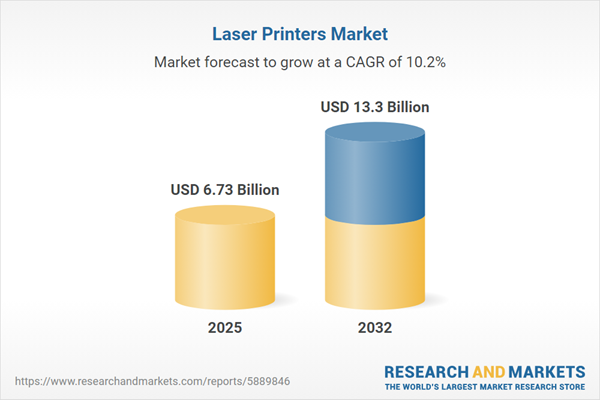Speak directly to the analyst to clarify any post sales queries you may have.
As organizations advance digital transformation initiatives, senior leaders are reevaluating how laser printers support information security, sustainability, and workflow performance. Evolving print infrastructure now plays a strategic role in adapting to hybrid workplaces, sector-specific compliance, and operational efficiency.
Market Snapshot: Laser Printers Market Size and Growth Outlook
The global laser printers market is valued at USD 6.11 billion in 2024 and is expected to climb to USD 6.73 billion by 2025, indicating a compound annual growth rate (CAGR) of 10.20%. The market is further projected to reach USD 13.30 billion by 2032.
Rising enterprise adoption is fueled by the need for energy-efficient solutions and enhanced document management that suits digital workflows. Providers are responding to these demands by aligning products with evolving sustainability priorities, greater device reliability, and new regulatory pressures. The introduction of managed print services and customizable offerings supports operational agility, positioning organizations to remain resilient as workflows and regulatory landscapes shift.Scope & Segmentation of the Laser Printers Market
- Functionality: Both color and monochrome printers help enterprises automate document processes, maintain branding standards, and support regulatory compliance throughout various operational scenarios.
- Product Type: Single-function units are designed for dedicated departmental workflows, while multifunction devices centralize tasks to enhance organization-wide visibility and control.
- Print Speed Category: Standard and high-speed models give businesses the flexibility to align output with workflow pace, facilitating productivity and process optimization.
- Print Volume: Options range from everyday office use to high-capacity devices, enabling scalable print resources as enterprise requirements grow or fluctuate.
- Application: Laser printers are deployed in the public sector, remote and hybrid workplaces, SMBs, and large enterprises, each requiring adaptable and reliable print solutions.
- Distribution Channel: Enterprises source devices through retail outlets, direct manufacturers, systems integrators, and e-commerce channels to respond efficiently to supply needs and changing dynamics.
- End User Industry: Sectors such as financial services, healthcare, education, manufacturing, and retail seek advanced security features and compliance-essential functionalities within their print infrastructure.
- Regions Covered: The Americas, Asia-Pacific, and EMEA markets demonstrate unique adoption trends shaped by digital maturity, regional compliance frameworks, and readiness for technological integration.
- Leading Companies: Major providers—HP Inc., Canon Inc., Seiko Epson, Brother Industries, Kyocera Document Solutions, Ricoh Company, Xerox Holdings, Konica Minolta, Lexmark International, and OKI Data Americas—offer solutions that address specific enterprise priorities.
Key Takeaways for Senior Decision-Makers
- Multifunction and network-ready printers enable organizations to quickly pivot and support hybrid or remote work environments, minimizing the need for broad system upgrades.
- Procurement strategies now focus on sustainability, driving demand for energy-efficient devices and closed-loop recycling programs to support broader environmental objectives.
- The integration of artificial intelligence and predictive analytics in device management enables proactive maintenance, boosting uptime and reducing workflow interruptions across distributed teams.
- Security features, including encryption and user authentication, have become essential for protecting confidential data, especially in highly regulated sectors and geographically dispersed operations.
- Enterprises diversify supply chains, balancing purchases from various channels to ensure ongoing device availability and to manage market fluctuations.
- Vendors are tailoring device features for specific industry compliance needs, particularly in finance and healthcare, where regulatory requirements continually evolve.
Tariff Impact: United States Policy Shifts Affecting Laser Printers Supply Chains
Recent changes in United States tariff regulations are introducing new complexities for the laser printers supply chain. These adjustments are prompting industry participants to assess local assembly and establish more diverse supplier networks to maintain a consistent supply. Multinational enterprises are encouraged to monitor policy developments closely and deploy adaptive sourcing approaches to manage cost volatility and secure supply continuity.
Methodology & Data Sources
This report uses a multi-method approach, drawing from executive interviews, expert panel input, and an independent assessment of shipment and financial records. This rigor ensures that senior leaders receive an up-to-date, transparent view of dynamics within the laser printers market.
Why This Report Matters to B2B Leaders
- Gives organizations actionable insights to enhance print infrastructure investment and procurement strategy as technology and compliance standards evolve.
- Supports agile decision-making by offering timely guidance relevant to new regulatory, technological, and workflow developments.
- Enables sustained alignment between document management, sector-specific needs, and ongoing technology plans through focused segmentation analysis.
Conclusion
Laser printers continue to evolve in critical areas such as security, sustainability, and workflow flexibility. B2B decision-makers who focus on strategic adaptation and compliance are positioned to strengthen operational resilience in a shifting business landscape.
Additional Product Information:
- Purchase of this report includes 1 year online access with quarterly updates.
- This report can be updated on request. Please contact our Customer Experience team using the Ask a Question widget on our website.
Table of Contents
3. Executive Summary
4. Market Overview
7. Cumulative Impact of Artificial Intelligence 2025
Companies Mentioned
The companies profiled in this Laser Printers market report include:- HP Inc.
- Canon Inc.
- Seiko Epson Corporation
- Brother Industries, Ltd.
- Kyocera Document Solutions Inc.
- Ricoh Company, Ltd.
- Xerox Holdings Corporation
- Konica Minolta, Inc.
- Lexmark International, Inc.
- OKI Data Americas, Inc.
Table Information
| Report Attribute | Details |
|---|---|
| No. of Pages | 191 |
| Published | October 2025 |
| Forecast Period | 2025 - 2032 |
| Estimated Market Value ( USD | $ 6.73 Billion |
| Forecasted Market Value ( USD | $ 13.3 Billion |
| Compound Annual Growth Rate | 10.2% |
| Regions Covered | Global |
| No. of Companies Mentioned | 11 |









